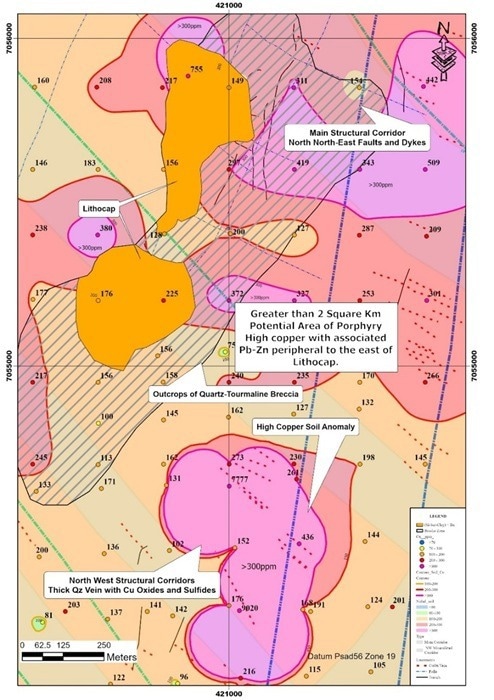Nobel Resources Corp. (the “Company” or “Nobel”) shared an update regarding advancements at its Cuprita Project (the “Project” or “Cuprita”) located in the Atacama Region of Chile.
 Compilation map showing the location of the extensive leached cap (lithocap) and associated structures, quartz-copper veins, soil geochemical anomalies, tourmaline breccias associated with a magnetic low, that comprise the key criteria for a mineralized porphyry target. Image Credit: Nobel Resources Corp.
Compilation map showing the location of the extensive leached cap (lithocap) and associated structures, quartz-copper veins, soil geochemical anomalies, tourmaline breccias associated with a magnetic low, that comprise the key criteria for a mineralized porphyry target. Image Credit: Nobel Resources Corp.
Nobel geologists have discovered a leach cap at Cuprita, which is associated with a copper, lead, and zinc anomaly in the soil.
This leach cap and the soil anomaly are positioned next to a ground magnetic low and near the convergence of a significant north-northeast-trending fault structure that intersects multiple northwest-trending quartz veins containing copper oxides. The intersection of major faults is often a critical structural factor for the formation of copper-gold porphyries in this area.
The detection of significantly anomalous copper in the soil surrounding the leach cap is a promising indicator of the potential existence of a mineralized porphyry deposit in the Cuprita project. The highest recorded copper values in the soil to date are found southeast of the exposed leach cap.
A substantial portion of the soil anomaly shows values exceeding 300% above the anticipated background levels for the region. Furthermore, the leach cap and soil anomaly coincide with a ground magnetic low, a typical indicator associated with mineralized systems in the area, where hydrothermal processes have altered the magnetic minerals.
Identifying a leach cap at Cuprita is particularly encouraging within a broader regional context. Leach caps are a crucial characteristic of intact porphyry systems in this area.
The recirculation of acidic fluids from the underlying buried porphyry often results in a bleached or iron oxide “rusty” appearance at the surface. The leach cap recognized by Nobel geologists displays classic hydrothermal alteration akin to that observed above a buried porphyry.
The presence of copper oxides, quartz veins, and remanent sulfides suggests the potential for mineralization beneath the leach cap, aligning with the region's established geological model.
Geological mapping has revealed a substantial area of tourmaline breccias that spans much of the target area, which is also regarded as a favorable pathfinder characteristic of productive porphyry systems.
From a geological perspective, Cuprita is situated within the Metallogenic Paleocene Porphyry Copper Belt, which contains several significant porphyry copper deposits, including El Salvador, Cerro Colorado, Spence, Sierra Gorda, and Fortuna, as well as various gold deposits. Recent fieldwork at Cuprita has assessed the project within the regional context and has refined the targeting for upcoming drilling programs.
Cuprita is demonstrating classic geological characteristics associated with a buried porphyry. The careful mapping completed to date has increased our excitement towards the Project and we are eager to drill Cuprita. At Cuprita, we have identified the key compelling geologic characteristics pointing to the potential for a mineralized porphyry system that has never been drill tested in a highly prolific copper region.
Larry Guy, Chaiman and Chief Executive Officer, Nobel Resources Corp.